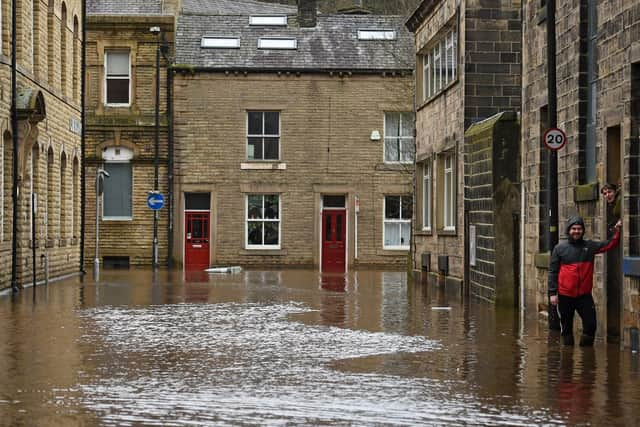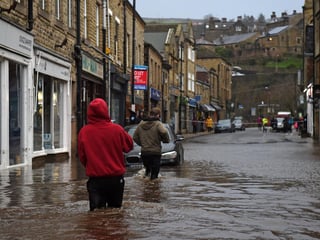Don't just build flood defences, we need natural measures to protect Calder Valley, says councillor on anniversary of Storm Ciara
Speaking a year on from Storm Ciara, which left 1,500 homes and businesses in Calderdale flooded, Scott Patient urged Boris Johnson to make some "bold and big" announcements on climate change at this year's United Nations Climate Change Conference in Glasgow.
The flooding was the second worst to hit the Calder Valley in recent years after the Boxing Day floods of 2015, but since February 9 last year the area has faced 16 flood alerts and warnings as well as a near miss in the form of last month's Storm Christoph.
Advertisement
Hide AdAdvertisement
Hide AdCoun Patient, the Labour-run authority's cabinet member for climate change, said communities Calderdale had not "always flooded to the sort of extent and frequency that they are doing now".
He said: "We've had four major ones in eight years and I've lost track of the amount of near misses we've had. We get things like this happening and we get a commitment to X amount of money for flood alleviation schemes, they're welcome, but I think tackling the root problem is where we need to be."
In last March's Budget, Chancellor Rishi Sunak announced that funding for flood defences in England would be doubled to £5.2bn over five years.
The funding - double the £2.6bn budgeted between 2015 and 2021 - is due to be available from April 2021.


Advertisement
Hide AdAdvertisement
Hide AdThe plan includes £200m for innovative projects such as sustainable drainage systems and temporary and permanent wildlife-friendly water storage areas, which will be tested in 25 areas at risk of flooding.
Coun Patient called for a "rebalancing" of funding away from big civil engineering projects towards the kind of natural flood defence schemes being tested in Calderdale.
A £41million flood alleviation scheme for Mytholmroyd, developed by the Environment Agency and the council, is now complete and will better protect around 400 homes and businesses this winter.
But other work includes nature-based solutions to flooding, like 'leaky dams' added to a stream or river to prevent soil and silt escaping and allowing water to escape at a slower rate, as well as restoring moorland and planting trees.
Advertisement
Hide AdAdvertisement
Hide AdGrants from the council and the Environment Agency in 2020 have helped to complete 15 natural schemes, with a further four in progress.
Coun Patient said: "Now only £200m of the £5.2bn was towards what they call innovative flood projects and that's the sort of stuff we're doing in Calderdale and we're quite well known for, natural flood management, peat restoration, leaky dam slow-the-flow work, and that makes a difference, it's low cost, it works with nature.
"I think that needs to be equalised, of a £5.2 billion pound pot only £200m of it has been available for those kinds of projects, so I'd like to see an equalisation of that.
"I'm not saying it should be entirely equal because civil engineering projects are great, the one in Mytholyroyd where I live is just complete and I think definitely provided that protection for us that we didn't have when Storm Ciara was here because it wasn't complete.
Advertisement
Hide AdAdvertisement
Hide Ad"But the other thing is just a more holistic approach to climate change really and tackling the root cause of why we keep flooding here. It's not just the river that makes us flood, it's water coming off the tops.
"It's looking at a holistic way of approaching it, working with landowners in terms of maintaining drainage ditches and old gullies, a full catchment plan for places like Calderdale that are the sort of places that keep flooding."
Following the Boxing Day 2015 floods the Calder Valley received £35m in funding from the Department for Environment, Food and Rural Affairs for flood and coastal risk management projects, £1m of which was ring-fenced for natural flood management projects.
Slow The Flow, a charity working to advance the education of the public in natural flood management, is involved in projects using the funding.
Advertisement
Hide AdAdvertisement
Hide AdGovernment officials believe that whilst natural solutions alone will not remove the risks of severe flooding, they can play a key role as part of a combination of actions across a catchment to drive down flood risk and bolster resilience.
A Defra spokesperson said: “Natural flood management measures are an important part of managing flood risk and coastal erosion, which is why we will double the number of government funded projects which include nature based solutions.
“As well as helping to reduce flood and coastal erosion risk, measures such as tree planting, peatland restoration, and wetland creation provide a myriad of other benefits - such as carbon sequestration, the creation of habitats for wildlife, and the creation of green spaces for communities.”
Comment Guidelines
National World encourages reader discussion on our stories. User feedback, insights and back-and-forth exchanges add a rich layer of context to reporting. Please review our Community Guidelines before commenting.
